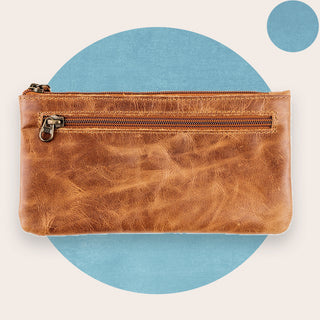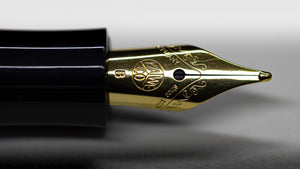No matter the activity, having quality tools matters. Felling a tree? A hatchet will do the job, but what an unpleasant experience. Painting your house? A disposable brush will work, but what a mess it will make.
The tool you pick makes a difference–hatchet or a chainsaw, cheap paintbrush or nicely balanced natural bristle brush? When you write your memoir, will it be with a cheap plastic BiC pen or the best fountain pen you can find?
Get the right tool for the right job, and learn to use it well. That leads to the best results and the most satisfying experience.

What Is a Fountain Pen?
Fountain pens were designed before the now-ubiquitous ballpoint and rollerball pens. But they're more modern than a dip pen or ink feathers, which must be reloaded every few lines from a messy inkwell.
Fundamentally, a fountain pen is a hybrid of the two types. Like a writing quill, it has a nib where ink collects. And like a ballpoint pen, fountain pens work thanks to an internal reservoir of ink. So their unique writing style has the best qualities of both–smooth writing with a long-lasting ink supply.
The tip used on these pens has come a long way since they were plucked from a beautiful avian's plumage. They're now made of metal, and the point can be anything from ultra-fine to broad.
Another difference between their modern counterparts is the longevity of a good fountain pen. They are designed to be easily refilled, not thrown in the rubbish bin with all the other single-use plastic garbage.
And, finally, in a manner befitting such an august writing implement, modern fountain pens are usually beautifully crafted. They are statement pieces, as much jewelry as a tool. There's no reason your pen should not look beautiful and write beautifully, right?
Why Use a Fountain Pen?
These pens write more readily than ballpoints, rollerballs, or gel pens without a tiny ball to clog. As a result, ink flows effortlessly to the paper, and most users experience less hand fatigue and a more pleasant writing experience. Writing with a good pen becomes not a chore, but a passion–something greatly missing in our digital age.
With a little practice, most fountain pen users also believe their handwriting improves. The smooth flow of ink on paper is freeing, making a more natural connection to the art of writing. Over time, the pen adapts to your writing style, making it much more personal than any other writing instrument.
Why Do You Use a Fountain Pen?
The quality of the writing experience is just one reason you might pick up a fountain pen. Here's a list of a few other reasons.
- Nostalgia – A certain generation learned to write with fountain pens, and using them reminds them of the "good ole days" in private school.
- Special occasions – There's something ceremonial about pulling a fancy pen out of your pocket and signing a piece of paper.
- Weight and feel – Fountain pens are built to last for years. So they're made to feel great in your hand, with just the right balance and grip.
- Community of enthusiastic users – Tons of online groups are dedicated to the art of writing with and collecting fountain pens.
- Cheaper and less wasteful – The fact that you can refill them means less waste and allows you to save money. So if you're sick of writing with low-quality junk that winds up in the landfill, grab a fountain pen and keep it forever.
- Status, hobby, and collectible – Like an expensive Italian handbag or a Swiss watch, a fine pen has accessory status. Collecting them is a hobby many enjoy. Plus, the best fountain pens look, well, really cool.
- Makes writing special – This is probably the most important reason for journalers. Writing with a special tool makes the experience of writing feel special. While some might like writing in theirs with fineliners or gel pens, others may simply get joy from using a smooth-writing fountain pen.
Why Use a Fountain Pen for Art
Artists have their own reasons for reaching for their best fountain pen. Of course, they appreciate the ease of use and the quality that fountain pens give, meaning glorious strokes that other writing implements can't match.
But another advantage is the wonderful array of fountain pen ink options. You can get any type of ink, in any colour or sheen, to put in your pen.
You can also interchange your pen's nib with different shapes. There are extra-fine nibs for details, bent nibs for calligraphy, and flex nibs that give your lines more variability.
How to Write With a Fountain Pen
If you grew up using cheap o ballpoint pens, getting comfortable with your fountain pen experience will take some practice. But fear not–you'll quickly reap the benefits once you get the basics down and it will soon be your go-to standard writing tool.
One of the first questions to answer is whether or not you'll put the cap on the top of the pen (posted) or leave it off (unposted). Most pens are designed to be balanced when posted, so keep that in mind.
Next, hold the pen like any other–pinched lightly between your thumb and index fingers and resting on the first knuckle of your middle finger. Then, approach the paper and find the sweet spot where the nib meets the paper at the correct angle (about 30 to 45-degrees), allowing the ink to flow smoothly.
Now write as you normally would, but focus on moving your arm, not just your fingers. Avoid using too much pressure and keep your strokes light, as pressing too hard can damage the nib and lead to smudged writing.
Always replace the pen's cap when finished writing. Leaving the pen uncapped will dry the ink, clog the nib, and possibly create a mess.
You don't need the most expensive model to get all the benefits. Even cheaper versions work great for everyday use.

Parts of a Fountain Pen
Here's a look at its inner workings and the best fountain pen features to look for.
Cap – Covers and protects the nib to ensure proper ink flow.
Barrel – The outer case or body of the pen. The handle or grip is designed to be comfortable to hold.
Nib – The writing point of most fountain pens is replaceable and comes in different styles.
Feed – The component that moves ink from the cartridge to the nib.
Cartridge – An integrated ink tank inside the barrel. There are replacements available or refillable ink cartridges. A converter changes a replaceable ink cartridge to a refillable one.
Final Words
So, there you have it! Writing with your first fountain pen really isn't that different. But like any quality tool, it makes the overall experience more rewarding and the final product more satisfying.
Fountain Pen Writing FAQs
Why would anyone use a fountain pen?
Fountain pens offer one of the most enjoyable experiences for handwriting. If you write a lot, they can help alleviate wrist and hand pain. They make your writing flow naturally, which is fun–but also cathartic. Beyond the quality of the writing experience, many use them because they are beautifully crafted works of art.
Why should we use fountain pen instead of ball pen?
Fountain pens aren't for everyone, but they offer advantages over ballpoint pens. The ink flows more readily, making writing flow easier with less pressure needed on the paper. Plus, fountain pens are beautiful in and of themselves, built to be easily refillable and to last a lifetime.
Are fountain pens good for daily use?
Fountain pens are great for daily use, so long as you enjoy using them. Of course, like all good tools, they are not for everyone. But people who do a lot of handwriting tend to appreciate them since they allow ink to flow smoothly and naturally on the paper.
Do you write better with a fountain pen?
Most users think their handwriting looks much better when made with a fountain pen. This is because the ink flows so easily from the nib, letting your lines take on details and a more unique writing style.



